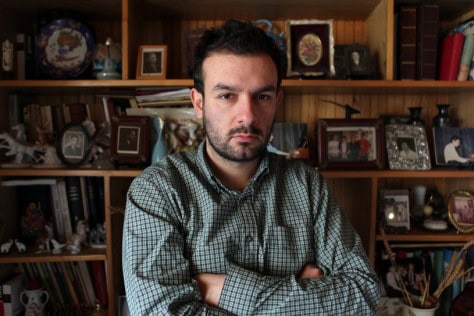A few months before Gary Panter's two-volume monograph was released by PictureBox Inc., we interviewed the longstanding L.A./N.Y.C. illustrator, designer, and comic artist, but since we're such fans of the legend's work, we're back to provide you all with another scoop on the guy, this time regarding his brand new retrospective book.
The oversized tome is split into two halves, one spotlighting Panter's sketchbooks, the other bringing forth his fine art efforts and intermingling with the pieces various essays by curators, writers, and fans of the artist. At 700 pages, Gary Panter is a hefty book to tackle, but very much worth the while. It's edited in such a way to make readers realize Panter as a fine artist first and jack-of-all-trades second; hundreds of pages are packed with paintings, pen-and-ink illustrations, and bizarre building prototypes rather than solely the off-kilter, angular, and “ratty line” comics Panter originally gained acclaim for in the late-1970s and early-1980s. There's even a good chuck of the first volume dedicated to Panter's childhood and lifetime experiences!
Here's a segment of one of the handful essays on the man featured in his new coffee table publication.
Richard Klein, “Taking Inventory”
Much of Panter's work exhibits both the formal and conceptual attributes found in children's drawing. The spontaneous and innocent character of children's art has influenced a broad range of artists over the past century, including major figures such as Picasso and Jean Dubuffet. If one looks critically at art inspired by the work of children, prior to the 1970s virtually any significant work was influenced solely by the art of the very young. Panter was one of the first to tap into the fantastically complex work done by children after the age of ten—particularly boys—when a concern for realism comes to the fore. This is the age when children start to make both graffiti and caricatures. Consider the drawings contained in a volume that Panter based on pornography. Resembling a 13-year-old boy's attempt at “realism,” the lewd and libidinous character of the subject matter has been subverted by a certain earnestness. Sexuality remains, but it is an awkward eros, and its translation by Panter's hand both celebrates and caricatures its vulgar origins.
Panter's first sketchbook dates from 1971, and he has currently filled a little over one hundred and counting. Perusing their pages one finds everything from expansive doodles to preliminary sketches for paintings to carefully considered observational drawings. Panter’s drawings from life, and in particular those illustrating places encountered on his travels, exhibit an economy of means and a surprisingly light hand. Sketchbook drawings such as Syosset Bar-B-Que, Sonic Boom, and Birdland are collections of expressive marks that individually pay tribute to each item considered. In Birdland, which is a drawing of Ed Ruscha's backyard in the Mojave Desert, the distinct character of each plant is revealed through a varying calligraphic shorthand.
Buy Gary Panter at D.A.P. and find out more about the publication at PictureBox Inc.
 Q&A with Larry Gus
Q&A with Larry Gus We Own the Night: The Edison
We Own the Night: The Edison
No Comments